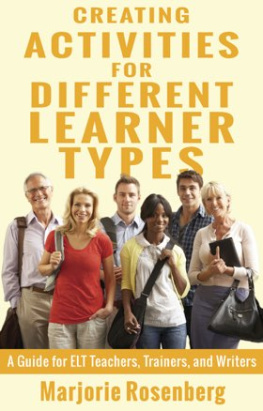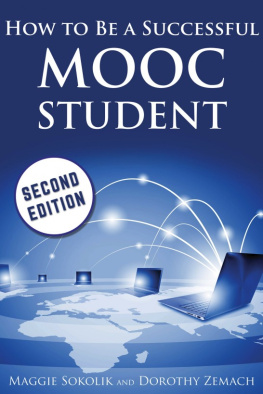How to Write an Essay, Workbook 1
Second Edition
Maggie Sokolik
Contents
H ow to Write an Essay , Workbook 1, Second Edition
Copyright 2016 by Maggie Sokolik
A ll rights reserved . No part of this publication may be reproduced, stored in or introduced into a retrieval system, or transmitted, in any form, or by any means (electronic, mechanical, photocopying, recording, or otherwise) without the prior written permission of the copyright owner. Dramatic works contained within this volume are intended only as reading material, and their inclusion does not imply the granting of performance licenses, which must be arranged through the author.
E dited by Dorothy E. Zemach . Cover design by DJ Rogers.
Published in the United States by Wayzgoose Press.
Introduction
T his workbook accompanies the online course, College Writing 2.1x, How to Write an Essay, the first of two courses offered by College Writing Programs of the University of California, Berkeley. You can find this course on the edx.org website ( http://edx.org/course/how-write-essay-uc-berkeleyx-colwri2-1x-0 ). This workbook offers additional ways to practice writing, editing, and reviewing the materials for the online course.
If you have purchased this workbook and are not taking the course, you may still find use for the materials. However, it should be noted that the course is offered free of charge, so look for the schedule on the http://edx.org website and join the live course.
Week 1: Good Grammar and Sentences
W eek 1 reviews the basics of grammar and how to write effective sentences. For some participants in the course, this will be nothing new. However, it is a good idea to be sure that you understand all the terms and can identify parts of sentences and grammatical terms easily. This makes talking about your writing easier. Sentences provide the building blocks for good writing.
T he purpose of freewriting is to improve your speed and fluency by writing without editing yourself as you write. Take out a pen and paper, or sit at your computer and write on the following idea (or any idea you want) for 5-10 minutes without stopping. Do not edit yourself for grammar, spelling, or any other reason. Let the thoughts just spill onto your page or screen, without thinking about whether they are right or wrong, good or bad.
Freewriting topic 1: What is your biggest problem in writing in English? How do you think you can improve your writing?
3
Excerpts from the Online Materials
T he following is a sample of key materials from this weeks lesson:
Keys to improving your writing
Write often! It doesnt matter what you write. Write about your day, something that you observed, reactions to your reading, etc. You will find suggestions for ideas to write about in your textbook.
Share your writing. Be sure you post to the discussion boards and get and give feedback to your peers.
Be patient. Learning to write well is a lifelong process. Keep working on it, and you will improve.
Find good resources. This course will provide you with lots of links and information. Keep it organized on your computer or in a notebook.
6 Steps to More Concise Writing
Concise means using no more words than necessary to convey your meaning. Here are six ways to achieve conciseness.
1. Avoid redundancy. Look at these expressions: The words in parentheses arent necessary. They say the same thing as the main phrase.
- ten p.m. (at night)
- tall (in height)
- our (final) conclusion
- (the month of) June
- square (in shape)
- to combine (together)
- to ask (a question)
- a consensus (of opinion)
2. Watch out for wordy phrases. Wordiness happens when you use more words than you need to say something. For example, in view of the fact that means simply because. Table 2 shows how you can express wordy phrases more concisely.
3. Make your subject clear and defined.
Unclear: The practice of revision would improve our writing.
Clear: Revision would improve our writing.
Avoid the empty subjects it and there (called expletives).
Empty: There is no way to become a better writer than to practice.
Defined: We can become better writers if we practice.
4. Use strongverbs. Avoid using sentences that rely overly on some form of the verb to be in combination with nouns or prepositions.
tobe + nouns: What we found was a solution to the problem.
Strong verb: We solved the problem.
5. Avoid vague words. Words like thing, stuff, material, people, get, or did should be replaced with more precise words.
Vague: I needed to get some stuff at the store.
Clear: I needed to buy some groceries at the farmers market.
6. Remove unnecessary modifiers. Too many modifiers weaken the force of your writing; they bury your main ideas in a mountain of words that dont mean much. Check for modifiers such as many, really, quite, in my opinion, etc., and edit them out of your writing.
Unnecessary modifiers: In my opinion, that movie was really quite good. Im very glad we saw it.
Concise: That movie was great! Im glad we saw it.
Sources for Grammar Terminology and Information
Websites
- Using English: http://www.usingenglish.com/glossary/
- About.com, Grammar: http://grammar.about.com/od/terms/a/100-Key-Grammatical-Terms.htm
- English Plus: http://englishplus.com/grammar/glossary.htm
- The Purdue OWL (online writing lab): http://owl.english.purdue.edu/owl/
- Revising Prose: http://www.ccp.rpi.edu/resources/revising-prose/
- Sentences: Simple, Compound, and Complex: http://eslbee.com/sentences.htm
Books
- Oxford Learners Grammar: Grammar Finder, by John Eastwood, Oxford University Press, 2005.
- Grammar for Writing, by Joyce Cain, Pearson Publishers, 2012. Three levels available.
- Rhetorical Grammar, by Martha Kolln and Loretta Gray, Longman Publishers, 2012.
- Effective Sentences: Writing for Success, by Jan Fluitt-Dupuy, University of Michigan Press, 2006.
- Gateways to Academic Writing: Effective Sentences, Paragraphs, and Essays, by Alan Meyers, Pearson Publishing, 2004.
- The Well-Crafted Sentence: A Writers Guide to Style, by Nora Bacon, Bedford/St. Martins Press, 2012.
I n controlled writing , you should pay close attention to form and structure, editing yourself for grammar, organization, and clear ideas.
Controlled writing topic 1: Write two or three paragraphs on the following topic: How is writing important to you in everyday life?















